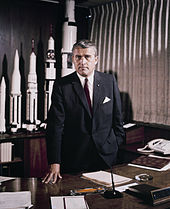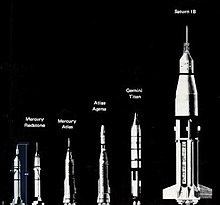User:Wd322/sandbox/1
Origins[edit]
Although Germans, Americans and Soviets experimented with small liquid-fuel rockets before World War II, launching satellites and humans into space required the development of larger ballistic missiles such as Wernher von Braun's Aggregat-4 (A-4), which became known as the Vergeltungswaffe 2 (V-2) developed by Nazi Germany to bomb the Allies in the war.[1] After the war, both the US and USSR acquired custody of German rocket development assets which they used to leverage the development of their own missiles.

Public interest in space flight was first aroused in October 1951 when the Soviet rocketry engineer Mikhail Tikhonravov published "Flight to the Moon" in the newspaper Pionerskaya pravda for young readers. He described a two-person interplanetary spaceship of the future and the industrial and technological processes required to create it. He ended the short article with a clear forecast of the future: "We do not have long to wait. We can assume that the bold dream of Konstantin Tsiolkovsky will be realized within the next 10 to 15 years."[2] From March 1952 to April 1954, the US Collier's magazine reacted with a series of seven articles Man Will Conquer Space Soon! detailing Wernher von Braun's plans for crewed spaceflight. In March 1955, Disneyland's animated episode Man in Space in the US television with an audience of about 40 million people eventually fired the public enthusiasm for space travel and raised government interest, both in the US and USSR.
Missile race[edit]
Soon after the end of World War II, the two former allies became engaged in a state of political conflict and military tension known as the Cold War (1947–1991), which polarized Europe between the Soviet Union's satellite states (often referred to as the Eastern Bloc) and the states of the Western world allied with the U.S.[3]
Soviet rocket development[edit]

The first Soviet development of artillery rockets was in 1921 when the Soviet military sanctioned the Gas Dynamics Laboratory, a small research laboratory to explore solid fuel rockets, led by Nikolai Tikhomirov, who had begun studying solid and liquid-fueled rockets in 1894, and obtained a patent in 1915 for "self-propelled aerial and water-surface mines.[4][5] The first test-firing of a solid fuel rocket was carried out in 1928.[6]
Further development was carried out in the 1930s by the Group for the Study of Reactive Motion (GIRD), where Soviet rocket pioneers Sergey Korolev, Friedrich Zander, Mikhail Tikhonravov and Leonid Dushkin[7] launched GIRD-X, the first Soviet liquid-fueled rocket in 1933.[8] In 1933 the two design bureaus were combined into the Reactive Scientific Research Institute[9] and produced the RP-318, the USSR's first rocket-powered aircraft and the RS-82 and RS-132 missiles,[10] which became the basis for the Katyusha multiple rocket launcher,[11][12] During the 1930s Soviet rocket technology was comparable to Germany's,[13] but Joseph Stalin's Great Purge from 1936 to 1938 severely damaged its progress.
In 1945 the Soviets captured several key Nazi German A-4 (V-2) rocket production facilities, and also gained the services of some German scientists and engineers related to the project. A-4s were assembled and studied and the experience derived from assembling and launching A4 rockets was directly applied to the Soviet copy, called the R-1,[14][15] with NII-88 chief designer Sergei Korolev overseeing the R-1's development.[16], The R-1 entered into service in the Soviet Army on 28 November 1950.[17][18] By the latter half of 1946, Korolev and rocket engineer Valentin Glushko had, with extensive input from German engineers, outlined a successor to the R-1, the R-2 with an extended frame and a new engine designed by Glushko, [19] which entered service in November, 1951, with a range of 600 kilometres (370 mi), twice that of the R-1.[20]. This was followed in 1951 with the development of the R-5 Pobeda, the Soviet Union's first real strategic missile, with a range of 1,200 km (750 mi) and capable of carrying a 1 megaton (mt) thermonuclear warhead. The R-5 entered service in 1955.[21] Scientific versions of the R-1, R-2 and R-5 undertook various experiments between 1949 and 1958, including flights with space dogs. [22]: 21–23
Design work began in 1953 on the R-7 Semyorka with the requirement for a missile with a launch mass of 170 to 200 tons, range of 8,500km and carrying a 3,000 kg (6,600 lb) nuclear warhead, powerful enough to launch a nuclear warhead against the United States. In late 1953 the warhead’s mass was increased to 5.5 to 6 tons to accommodate the then planned theromonuclear bomb.[23][24] On the 21 August 1957 the R-7 flew 6,000 km (3,700 mi), and became the worlds’s first intercontinental ballistic missile.[25][24] Two months later the R-7 launched Sputnik 1, the first artificial satellite, into orbit, and became the basis for the R-7 family which includes Sputnik, Luna, Molniya, Vostok, and Voskhod space launchers, as well as later Soyuz variants. Several versions are still in use and it has become the world’s most reliable space launcher.[26][27]
American rocket development[edit]

Although American rocket pioneer Robert H. Goddard developed, patented, and flew small liquid-propellant rockets as early as 1914, he became a recluse when his ideas were ridiculed by an editorial in The New York Times. This left the United States as the only one of the major three World War II powers not to have its own rocket program, until Von Braun and his engineers were expatriated from Nazi Germany in 1945. The US acquired a large number of V-2 rockets and recruited von Braun and most of his engineering team in Operation Paperclip.[28] The team was sent to the Army's White Sands Proving Ground in New Mexico, in 1945.[29] They set about assembling the captured V-2s and began a program of launching them and instructing American engineers in their operation.[30] These tests led to the first photos of Earth from space, and the first two-stage rocket, the WAC Corporal-V-2 combination, in 1949.[30] The German rocket team was moved from Fort Bliss to the Army's new Redstone Arsenal, located in Huntsville, Alabama, in 1950.[31] From here, von Braun and his team developed the Army's first operational medium-range ballistic missile, the Redstone rocket, derivatives of which launched both America's first satellite, and the first piloted Mercury space missions.[31] It became the basis for both the Jupiter and Saturn family of rockets.[31]

Each of the United States armed services had its own ICBM development program. The Air Force began ICBM research in 1945 with the MX-774.[32] In 1950, von Braun began testing the Air Force PGM-11 Redstone rocket family at Cape Canaveral.[33] By 1957, a descendant of the Air Force MX-774 received top-priority funding.[32] and evolved into the Atlas-A, the first successful American ICBM.[32] Its upgraded version, the Atlas-D, later served as a nuclear ICBM and as the orbital launch vehicle for Project Mercury and the remote-controlled Agena Target Vehicle used in Project Gemini.[32]
- ^ Neufeld, Michael J (1995). The Rocket and the Reich: Peenemünde and the Coming of the Ballistic Missile Era. New York: The Free Press. pp. 158, 160–62, 190. ISBN 978-0-02-922895-1.
- ^ Siddiqi 2000, p. 89.
- ^ Schmitz 1999, pp. 149–54.
- ^ Siddiqi 2000, p. 6.
- ^ Chertok 2005, p. 164-5 Vol 1.
- ^ Chertok 2005, p. 165 Vol 1.
- ^ Siddiqi 2000, p. 4-5.
- ^ "GIRD (Gruppa Isutcheniya Reaktivnovo Dvisheniya)". WEEBAU. Retrieved 26 July 2022.
- ^ Zak, Anatoly. "Gas Dynamics Laboratory". Retrieved 9 June 2022.
- ^ Chertok 2005, p. 167 vol 1.
- ^ "Greatest World War II Weapons: The Fearsome Katyusha Rocket Launcher". Defencyclopidea. February 20, 2016. Retrieved 20 May 2022.
- ^ Siddiqi 2000, p. 9.
- ^ Chertok 2005, p. 167-8 Vol 1.
- ^ Siddiqi 2000, p. 24-39.
- ^ Chertok 2005, p. 41 Vol 2.
- ^ Siddiqi 2000, p. 49.
- ^ Zaloga, Steven J. (20 March 2013). V-2 Ballistic Missile 1942–52. Bloomsbury Publishing. p. 41. ISBN 978-1-4728-0299-6.
- ^ Zaloga, Steven J. (20 March 2013). "R-11: the Scud A". Scud Ballistic Missile and Launch Systems 1955–2005. Bloomsbury Publishing. pp. 6–15. ISBN 978-1-4728-0306-1.
- ^ Siddiqi 2000, p. 42.
- ^ Chertok 2005, p. 48-49 Vol 2.
- ^ Chertok 2005, p. 242-285 Vol 2.
- ^ Brian Harvey; Olga Zakutnyaya (2011). Russian Space Probes: Scientific Discoveries and Future Missions. Chichester,UK: Springer Praxis Books. OCLC 1316077842.
- ^ Siddiqi 2000, p. 128-132.
- ^ a b "The Military Rockets that Launched the Space Age". National Air and Space Museum. Retrieved 24 December 2023.
- ^ Siddiqi 2000, p. 160-161.
- ^ "Russian Rockets and Space Launchers". Historic Spacecraft. Retrieved 26 December 2023.
- ^ Zak, Anatoly. "The R-7 intercontinental ballistic missile". Russian Space Web. Retrieved 29 December 2023.
- ^ Schefter 1999, p. 29.
- ^ Burrows 1998, p. 123.
- ^ a b Burrows 1998, pp. 129–34.
- ^ a b c Burrows 1998, p. 137.
- ^ a b c d Wade, Mark. "Atlas". Encyclopedia Astronautix. Archived from the original on July 10, 2016. Retrieved September 28, 2020.
- ^ Koman, Rita G. (January 1, 1994). "Man on the Moon: The U.S. Space Program as a Cold War Maneuver". OAH Magazine of History. 8 (2): 42–50. doi:10.1093/maghis/8.2.42. JSTOR 25162945.

